Miele G 7783 MIELABOR Operating instructions
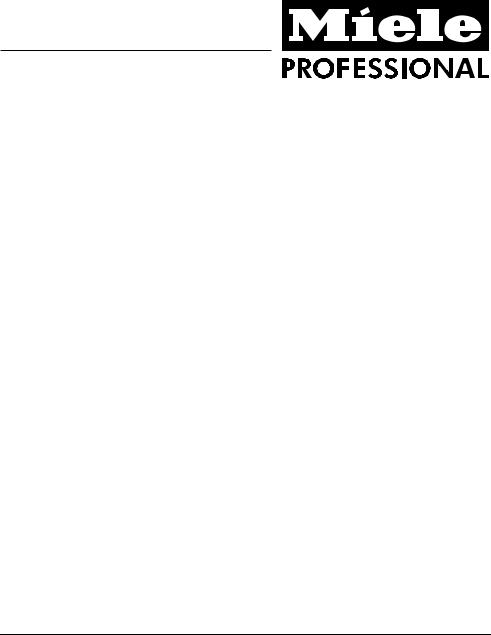
Operating Instructions
Laboratory Glasswasher
G 7783 MIELABOR
It is essential to read these operating instructions before installing or using the machine, to avoid the risk of accident
or damage to the machine.
Q@
M.-Nr. 03 885 802

Contents
Guide to the machine. . . . . . . . . . . . . . . . . . . . . . . . . . . . . . . . . . . . . . . . . . . . . . . 3
Warning and safety instructions. . . . . . . . . . . . . . . . . . . . . . . . . . . . . . . . . . . . . . 5
Warning and safety instructions (detachable) . . . . . . . . . . . . . . . . . Centre pages
Description of the machine . . . . . . . . . . . . . . . . . . . . . . . . . . . . . . . . . . . . . . . . . . 9
Setting the water softener . . . . . . . . . . . . . . . . . . . . . . . . . . . . . . . . . . . . . . . . . . 10
Opening and closing the door . . . . . . . . . . . . . . . . . . . . . . . . . . . . . . . . . . . . . . 12
Applications and loading. . . . . . . . . . . . . . . . . . . . . . . . . . . . . . . . . . . . . . . . . . . 13
Rinsing agent . . . . . . . . . . . . . . . . . . . . . . . . . . . . . . . . . . . . . . . . . . . . . . . . . . . . 17
– Setting the dosage. . . . . . . . . . . . . . . . . . . . . . . . . . . . . . . . . . . . . . . . . . . . . . . 17
Adding neutralising agent . . . . . . . . . . . . . . . . . . . . . . . . . . . . . . . . . . . . . . . . . . 18
Liquid dispensing system venting / Maintenance. . . . . . . . . . . . . . . . . . . . . . . 19
Adding powder detergent . . . . . . . . . . . . . . . . . . . . . . . . . . . . . . . . . . . . . . . . . . 20
Programme selection. . . . . . . . . . . . . . . . . . . . . . . . . . . . . . . . . . . . . . . . . . . . . . 21
Programme chart . . . . . . . . . . . . . . . . . . . . . . . . . . . . . . . . . . . . . . . . . . . . . . . . . 22
Switching the machine on and off . . . . . . . . . . . . . . . . . . . . . . . . . . . . . . . . . . . 24
– Selecting a programme . . . . . . . . . . . . . . . . . . . . . . . . . . . . . . . . . . . . . . . . . . . 24
– Selecting an additional programme. . . . . . . . . . . . . . . . . . . . . . . . . . . . . . . . . . 24
– Programme sequence indicator . . . . . . . . . . . . . . . . . . . . . . . . . . . . . . . . . . . . 25
– Interrupting a programme . . . . . . . . . . . . . . . . . . . . . . . . . . . . . . . . . . . . . . . . . 25
Programming special functions . . . . . . . . . . . . . . . . . . . . . . . . . . . . . . . . . . . . . 26
Reactivating the water softener . . . . . . . . . . . . . . . . . . . . . . . . . . . . . . . . . . . . . 28
Cleaning and care . . . . . . . . . . . . . . . . . . . . . . . . . . . . . . . . . . . . . . . . . . . . . . . . 30
Correcting minor faults . . . . . . . . . . . . . . . . . . . . . . . . . . . . . . . . . . . . . . . . . . . . 32
Installation . . . . . . . . . . . . . . . . . . . . . . . . . . . . . . . . . . . . . . . . . . . . . . . . . . . . . . 33
Electrical connection U.K./AUS . . . . . . . . . . . . . . . . . . . . . . . . . . . . . . . . . . . . . 35
Plumbing. . . . . . . . . . . . . . . . . . . . . . . . . . . . . . . . . . . . . . . . . . . . . . . . . . . . . . . . 37
Caring for the environment . . . . . . . . . . . . . . . . . . . . . . . . . . . . . . . . . . . . . . . . . 40
Technical data . . . . . . . . . . . . . . . . . . . . . . . . . . . . . . . . . . . . . . . . . . . . . . . . . . . 41
2
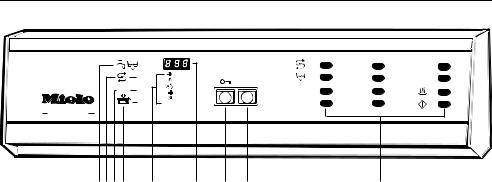
Guide to the machine
|
|
°C |
|
|
|
|
|
• min |
|
• |
|
|
|
• |
|
|
|
|
|
|
• |
I-O |
|
|
DOS |
• |
|
• |
|
|
|
|
• |
|
|
MIELABOR G 7783 |
|
• |
DESIN |
• |
|
|
|
• |
|
||
MULTITRONIC |
|
|
|
|
|
|
• |
C |
• |
T1 • |
|
• |
D |
• |
T2 • |
A |
• |
E |
• |
• |
B |
• |
F |
• |
• |
|
12 3 4 |
5 |
6 |
7 |
8 |
9 |
1 |
“Check water inlet/outlet” |
|
|
4 |
“Add neutralising agent” |
|
|
indicator light |
|
|
|
|
indicator light |
2 |
“Reactivate softener” |
|
|
|
5 |
Programme sequence indicator |
|
indicator light |
|
|
|
6 |
Display field |
|
|
|
|
|
||
3 |
“Add liquid detergent” |
|
|
7 |
Door release |
|
|
indicator light |
|
|
|
||
|
|
|
|
|
|
|
|
(only with externally connected |
|
8 |
On-Off button (I-0) |
||
|
DOS-Module –special version–) |
|
9 |
Programme selectors |
||
|
|
|
|
|
||
3
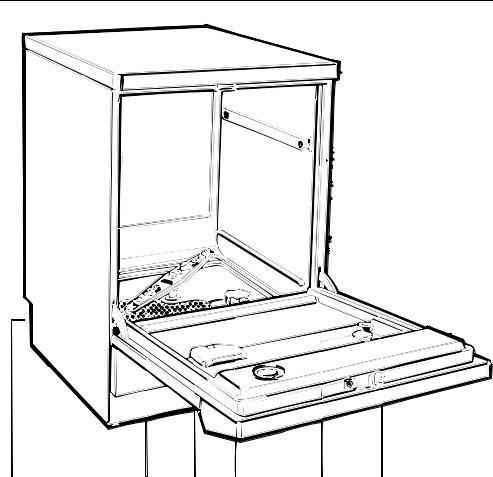
Guide to the machine
10 |
11 |
12 |
13 |
14 |
15 |
10Connection for DOS-Module (at rear)
11Filter combination
12Dispenser for powder detergent
13Connection socket for salt container (Water softener)
14Dispenser for liquid rinsing agent with dosage selector
15Level indicator
4

Warning and safety instructions
This machine conforms to current safety requirements. Inappropriate use can however lead to personal injury and damage to property.
Read the operating instructions carefully before starting to use this machine. This way you will avoid the risk of accidents, and damage to the machine.
Keep these instructions in a safe place, and make them available to future users.
Correct usage
This machine is designed for commercial use and for specialised ap-
plications only, as described in these Operating Instructions. Using it for purposes other than those for which it was designed would be unauthorised and could cause harm.
The manufacturer cannot be held responsible for damage caused by improper use.
Please pay attention to the following notes, to maintain safe procedures.
The machine should be commissioned and then maintained only by the Miele Service Department, an
authorised Miele Service Dealer or other approved competent person.
Do not install the machine in an area where a danger of explosion
may be present.
The electrical safety of this machine can only be guaranteed if
connected to a correctly installed earthing system on site. It is most important that this basic safety requirement is met and complies with local and national regulations. It should be checked by an expert if necessary.
The manufacturer cannot be held responsible for damage caused by missing or defective earthing, such as electric shock.
A damaged machine is dangerous. Switch off at the mains im-
mediately and call an authorised Miele service dealer, or suitably competent engineer.
Repair work may only be carried out by an authorised, suitably com-
petent person. Repairs by unqualified persons could be dangerous.
Personnel operating the machine should be trained regularly. Children and untrained personnel should not
be allowed access to the machine or its controls.
Accessories
Use special inserts in accordance with the instructions provided.
5

Warning and safety instructions
Take care when handling liquids such as detergents, wetting
agents, or neutralising agents. These may contain irritant or corrosive ingredients, acids or alkalis. On no account use any organic solvent, as there may be the danger of an explosion occurring.
Follow the instructions and relevant safety procedures carefully. Wear protective gloves and goggles.
Avoid inhalation of powder cleaners. They can cause burning
in the mouth and throat if swallowed, or inhibit breathing.
The water in the machine must not be used as drinking water.
Do not sit or lean on the open door, or rest objects on it. This
could cause the machine to tip and be damaged.
Be careful when sorting items with sharp pointed ends and positioning them in the machine that you do not
hurt yourself or create danger for other operators.
When using this machine in the temperature ranges from 70 to
95°C be especially careful not to scald or burn yourself. Baskets and inserts must first cool down. Any water which may remain in containers will be very hot and must be emptied into the wash cabinet.
Do not touch the heating elements during or directly after the end of a
programme, you could burn yourself.
Never use an ordinary or a high pressure hose on or in the vicinity
of the machine.
Before any maintenance or repair work is undertaken, the machine must be disconnected from the mains
supply, by switching off at the mains isolator, or withdrawing the mains fuse.
The following points should be observed to avoid damage to the machine and the loads being cleaned.
The standard of disinfection in the Disinfection programmes must be confirmed by the user as a routine mat-
ter. The process should be regularly checked using chemical indicators, and bacteriologically at intervals using bio-indicators, with full documentation. Proceed according to local health authority regulations.
Disinfection programmes must not be interrupted, as this can have a limiting effect on the disinfection result.
However, should an interruption be necessary. the complete programme must be repeated.
Only use cleaning agents formulated for special processes and ap-
proved by Miele for use with this machine. Use of unsuitable cleaning agents could adversely affect the load or the machine.
6

Warning and safety instructions
For pre-treatment and / or cleaning only use low-foaming detergents
and disinfecting agents which have been approved by Miele. Foam can have an adverse effect on the disinfection and cleaning process.
Where a chemical additive is recommended on technical applica-
tion grounds (for example with a cleaning agent), this does not imply that the manufacturer of the machine takes responsibility for the effect of the chemical on the material of the items being cleaned. Please be aware that change- s in formulation, storage conditions etc, which may not be publicised by the chemical producer, can have a negative effect on the cleaning result.
When using cleaning agents and specialised products it is essential
that the manufacturer’s instructions are followed. Only use the product for the application described by the manufacturer, to avoid any material damage or the occurrence of strong chemical reactions such as oxyhydrogen.
The machine is designed only for operation with water and additive
cleaning agents. Organic solvents must not be used in the machine, as there is the danger under certain circumstances of explosion. Although this is not the case with all organic solvents, other problems could arise with their use, for example damage to rubber and synthetic materials.
In critical applications where very stringent requirements have to be
met, it is strongly recommended that all the relevant factors for the process, such as cleaning agent, quality of water are discussed with the Miele Application Technology specialists.
If the cleaning result is subject to these particularly stringent requirements (e.g. chemical analysis, specialised processes), a regular quality control test should be carried out by the user to ensure that required standards of cleanliness are being achieved.
Please follow the advice on installation in these instructions and the
separate Installation Instructions.
Empty any containers or utensils before arranging them in the ma-
chine.
Do not allow any remains of acids or solvents, or chloride solutions to
get into the wash cabinet. Similarly avoid any materials with a corrosive effect.
The presence in compounds of any solvents should be minimal, (especially those in hazard class A1).
Ensure that solutions or steam containing acid salts do not come into
contact with the steel outer casing of the machine, to avoid any corrosion damage.
Use special inserts in accordance with the instructions provided.
7

Warning and safety instructions
Accessories
The only accessories to be used with the special commercial machine must be those supplied or ap-
proved by MIELE for the specific application. Consult your dealer or the Miele Professional department for advice.
Disposal of an old machine
When disposing of an old machine first make it unusable. Disconnect, cut off the cable and any plug from the
cable. For environmental and safety reasons ensure the machine is completely drained of any residue water and cleaning agent. (Observe safety regulations and wear safety goggles and gloves). Make the door lock inoperative, so that children cannot accidentally shut themselves in. The simplest way to do this is to remove the locking pin (2 philips screws above the door). Make appropriate arrangements for the safe disposal of the machine. For tank system machines ensure that any water is emptied out of the tank.
In countries where there are areas which may be subject to infesta-
tion by cockroaches or other vermin, pay particular attention to keeping the machine and its surroundings in a clean condition at all times. Any damage which may be caused by cockroaches or other vermin will not be covered by the machine guarantee.
The manufacturer cannot be held responsible for any damage caused through non-observance of these Warning and Safety instructions.
8

Description of the machine
The G 7783 is a front-loading automatic machine for the efficient washing - neutralising - rinsing - final rinsing of laboratory glassware. It can be operated on normal water supply. There are “AD” (aqua destillata) programmes with final rinses using purified water (distilled, R.O., or de-ionised).
On completion of the automatic programme sequence, laboratory glassware is cleaned to the standard required for analysis.
The electronic control unit offers a choice of temperatures for the cleaning and final rinsing phases. A combination often preferred is cleaning - T1 85°C and final rinse T2 70°C.
With the SPECIAL “B” programme the machine can thermally disinfect at 90°C with relevant holding times.
“Instrument disinfection in automatic machines” is to be found under subsection 3.2.4. of paragraph 10c of BSeuchG, according to the German Federal Health Authority, Berlin (BGA). The disinfection parameters of between 90°C and 93°C held for 10 minutes apply to the effective areas A + B.
Reduction factor 7 (by reduction factor ~107).
The effective areas are defined as follows:
A = Suitable for destruction of vegetative bacteria, including myco-bacteria and fungus and fungal spores.
B = Suitable for inactivation of viruses (including HBV and HIV).
The SPECIAL “B” programme operates at 90°C with 10 minutes holding time.
9

Setting the water softener
To avoid the build-up of calcium deposits on glassware and in the machine the water needs to be softened, where the supply hardness exceeds 107 ppm, (6°d).
To ensure a steady supply of soft water the water softener unit must always be:
1.correctly set, and
2.regenerated with salt as soon as the k indicator light comes on.
The water softener must be set to correspond with the water hardness the first time the machine is used.
Your local water authority will advise you on the water hardness in your area.
Setting the Water Softener
The hardness range is divided into 18 “time” units and a zero position. The machine is set at the factory at time unit ’8’, corresponding to 339 ppm, (19 °d).
If your water supply is harder or softer than this, then:
Use the touch pads on the control panel to change the time setting (see Table).
Time- |
°d |
mmol/ |
° f |
°e |
ppm |
set- |
|
l |
|
|
CaCO3 |
ting |
|
|
|
|
|
|
|
|
|
|
|
18 |
6 |
1,07 |
10,7 |
7,5 |
107 |
17 |
7 |
1,25 |
12,5 |
8,8 |
125 |
16 |
8 |
1,43 |
14,3 |
10,0 |
143 |
15 |
9 |
1,60 |
16,0 |
11,3 |
160 |
14 |
10 |
1,79 |
17,9 |
12,5 |
179 |
13 |
11 |
1,96 |
19,6 |
13,8 |
196 |
12 |
12 |
2,14 |
21,4 |
15,0 |
214 |
11 |
13 |
2,32 |
23,2 |
16,3 |
232 |
10 |
15 |
2,67 |
26,8 |
18,8 |
268 |
9 |
17 |
3,04 |
30,4 |
21,3 |
304 |
8 |
19 |
3,38 |
33,9 |
23,8 |
339 |
7 |
22 |
3,93 |
39,3 |
27,5 |
393 |
6 |
24 |
4,28 |
42,8 |
30,0 |
428 |
5 |
28 |
5,00 |
50,0 |
35,0 |
500 |
4 |
32 |
5,71 |
57,1 |
40,0 |
571 |
3 |
38 |
6,78 |
67,8 |
47,6 |
678 |
2 |
48 |
8,57 |
85,7 |
60,1 |
857 |
1 |
71 |
12,67 |
126,7 |
88,9 |
1267 |
0 |
|
|
|
|
|
|
|
|
|
|
|
Press T1 and c touch pads simultaneously, keep them held down and switch on the machine with the main switch"I-0".
The current programming status “P...” will appear in the display field.
Press touch pad k. The “P” will disappear and setting “0" will always appear in the display field. This setting ”0" can now be changed if necessary. To do this:
Press touch pad c as many times as is necessary for the desired value to appear in the display field.
Press touch pad h. “SP” appears.
Press h once again. The setting will now be stored. The display field clears.
The machine is now ready for operation.
10

Setting the water softener
If the water hardness in your area is permanently below 107 ppm (6 d):
Select setting “0".
The control light k will not come on and the water softener does not need to be reactivated.
See section on Reactivating the water softener.
11

Opening and closing the door
To open the door a
Press the release catch as far as it will go and, at the same time, grasp the door grip and open the door.
The door should only be opened during operation for emergencies: e.g. if articles are knocking together (see “Interrupting a programme”).
To close the door
Lift the door upwards and push until it clicks into position. Do not press the release catch.
12
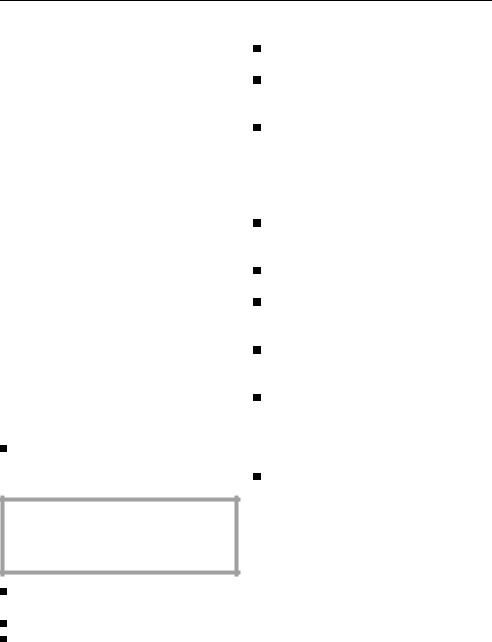
Applications and loading
This laboratory glasswasher normally requires a top and a bottom basket.
Depending on the type and shape of the glassware, inserts can be supplied. The diversity of the inserts is so great that it is not possible to illustrate them all or give detailed instructions on their use here. As an example there are inserts for direct injection spraying of volumetric flasks, butyrometers, pipettes etc.
General glassware used in laboratories, e.g. beakers, conical flasks, test tubes, etc., can be arranged in fullsize, half or quarter inserts in top or bottom baskets. Your Miele laboratory dealer will advise on specific requirements.
The following instructions relate only to basic preparation and loading of glassware.
Arranging the load
Removing excess soils
Empty all glassware before loading into the machine, (observe any applicable hygiene regulations).
Ensure that no acid or solvent residues, especially hydrochloric acid or chlorides get into the wash cabinet.
Remove all agar residues from petri dishes.
Remove blood clots and residues. Remove all stoppers, corks, labels, sealing wax residues, etc.
Please note:
Load the glassware so that water will come into contact with all surfaces. Do not place items to be cleaned inside other pieces where they may be concealed.
Hollow vessels such as beakers, measuring cylinders, flasks, etc. should be inverted and placed in the correct inserts. A cover net can be used to reduce the risk of movement during the wash process.
Petri dishes and similar should be placed in the correct insert with the soiled side facing the centre. Pipettes should be placed with the mouthpiece facing upwards.
Deep based items should be placed at enough of an angle for water to run off them freely.
Tall, narrow, hollow pieces should be placed in the centre of the basket to ensure good coverage of water.
Do not cover the funnel in the middle of the top basket. Mobile injector units or baskets with an adapter must engage correctly, (see next page).
The spray arms must not be blocked by items which are too tall for the basket or which hang down in their path. If necessary, manually rotate the arms to test this.
13
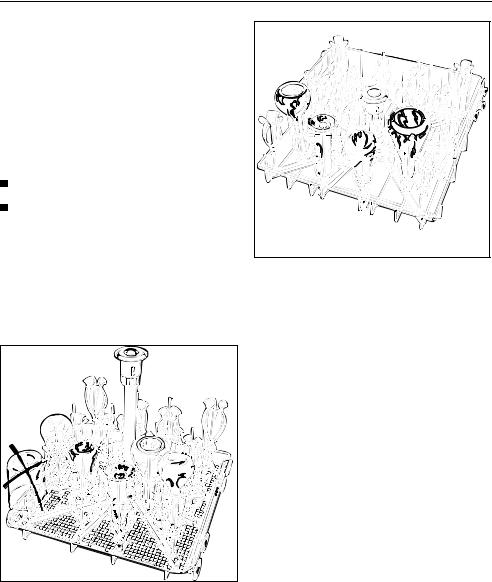
Applications and loading
Important:
Make sure that the spring adapter for water connection engages correctly when a basket, injector or mobile unit is inserted into the machine. It must be 4- 5 mm higher than the water connection inlet in the roof of the cabinet.
If it is not, adjust the adapter accordingly.
Loosen the lock ring.
Push up the adapter (4-5 mm higher than the water connection inlet) and tighten the lock ring.
Select baskets and inserts which are appropriate for the application.
Loading examples:
E 350
“Intermiel” injector mobile unit
For narrow necked glassware, complete with 15 nozzles 4x1 mm/160 mm high, 18 nozzles 6x1 mm/220 mm high with 33 “Mielava” clips.
O 187
Injector mobile unit
(top basket) for direct injection of narrow necked glassware, 34 nozzles 4x1 mm/160 mm high with “Mielava” clips.
Important: With insert O 187 either liquid detergent must be used, (special accessory DOS module C 60), or powder must be placed only on the inside of the door.
14
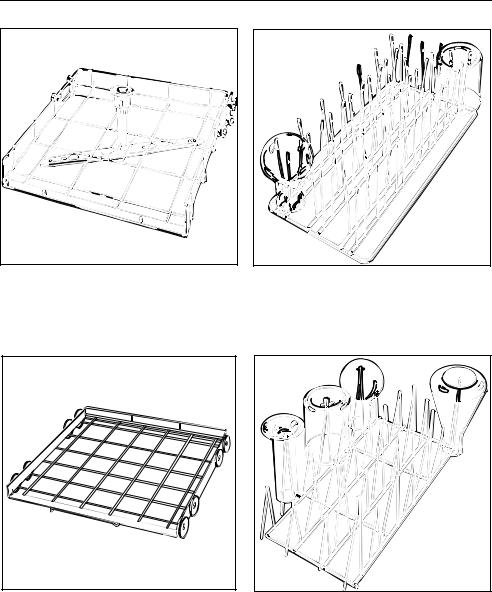
Applications and loading
O 188 top basket frame
can take various inserts.
U 174 bottom basket frame
can take various inserts.
E 109 |
Half insert, stainless steel, for 21 glass beakers up to 250 ml, round and conical flasks etc.
E 106 |
Half insert, st. steel, with 28 spring hooks at two heights for glassware, e.g narrow necked bottles, measuring cylinders, medicine bottles etc.
15
